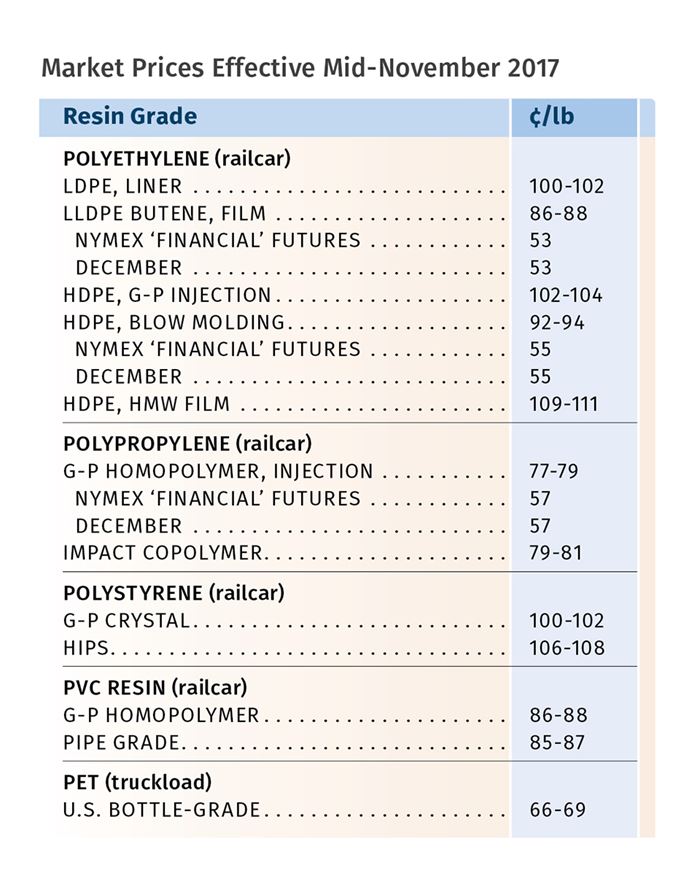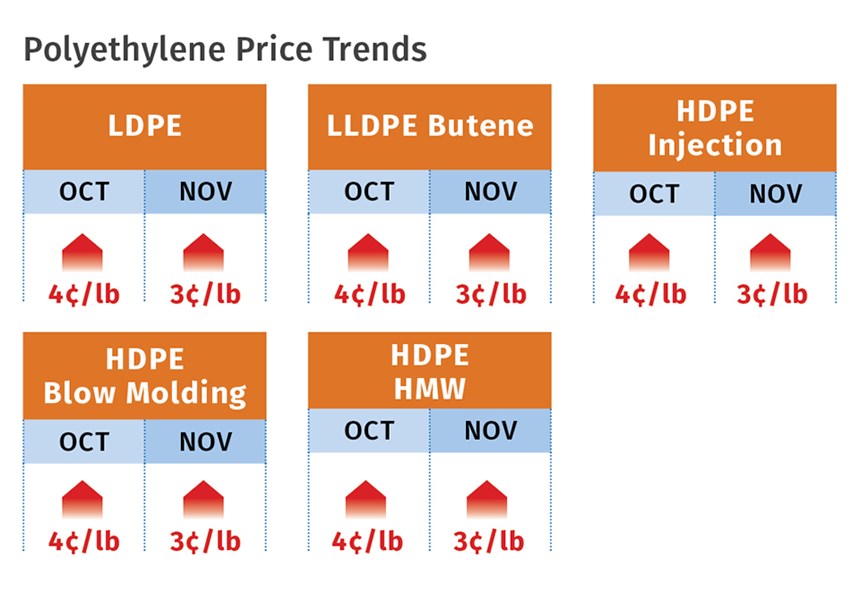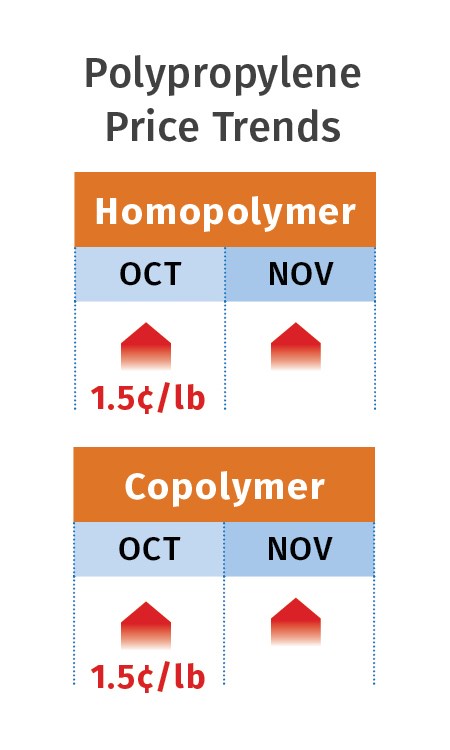Resin Prices Up, But Not for Long
A turnaround is foreseen for PE, PP, PS, PVC, and PET, based on supply-demand balance and/or feedstock costs.
Commodity resin prices appeared to be holding firm or rising at the start of November, as suppliers aimed to implement price increases and/or margin expansions. But the industry’s faster-than-expected rally to meet post-Hurricane Harvey feedstock and resin production challenges is pointing to a reversal in the pricing trajectory—or at least some stability—as as we head into the new year.
These are the views of purchasing consultants from Resin Technology, Inc. (RTi), Fort Worth, Texas, CEO Michael Greenberg of Plastics Exchange, The in Chicago, and Houston-based PetroChemWire (PCW).
PE PRICES UP FOR NOW
Polyethylene prices moved up another 3¢/lb by November, bringing contract prices up to 10¢/lb higher than July levels. Mike Burns, RTi’s v.p. of client services for PE, believed that a reversal in the pricing trajectory was already underway in November. “Expect continued downward pressure, though suppliers will aim to hold onto their increases.” Not only did he not see any market drivers that would support new increases, but he did not see how current price levels could be sustained as supply improves. He ventured that most if not all of these “purely” hurricane-related increases would fall by the wayside in the first quarter of 2018.
PCW reported that spot PE prices were flat to lower as availability continues to improve. Domestic sales were expected to weaken in the final two months of 2017 as processors correct from heavy buying in September-October and seasonal slowdowns set in.
The Plastics Exchange’s Greenberg noted that domestic and Houston PE prices have been well above international levels, but as domestic supply conditions improve and export outlets for new PE production are sought, Houston prices will start to drop. “It will be difficult for the domestic PE market to maintain a massive premium over exports for an extended period, so we expect PE for domestic consumption to also see pressure ahead.”
PP PRICES PEAKED?
Polypropylene prices moved up in October by 1.5¢/lb, in step with the October propylene monomer contract settlement. PCW reported that PP suppliers had been phasing in their 3¢/lb margin expansion since August, with one supplier aiming to implement that increase in November. With no major capacity expansions on the horizon, North American PP supply was expected to remain balanced to tight and provide supplier pricing leverage.
However, Scott Newell, RTi’s v.p. of PP markets, said that aside from the 1.5¢/lb October increase, it did not appear that the 3¢/lb margin expansion was widely implemented. He thought a 2-3¢/lb increase would be pushed through ultimately, but also ventured that monomer prices may have topped out—noting that spot monomer prices were starting to drop. Newell also added that the new Enterprise Products Partners propylene unit was being brought on stream, further easing monomer tightness.
While PP inventories were still low in early November, it did not appear that processors had any trouble getting what they needed, according to Newell. And, while August-September PP production output was very low, he expected October-November production levels to improve.
“This, along with some demand destruction as prices increased, and a bit of softer demand as people hold off buying,” could lead to price erosion, he said. Noting that PP contract prices had moved up a total of 12¢/lb, including 1.5-2¢ in October, Greenberg reported, “While producers will continue to seek to expand margins, we believe the market will also be heavily influenced by monomer costs ahead. While PP prices took a small dip, we expect PP to stay relatively firm as there is no new production on the horizon.” He added that the gap between domestic and import prices “is not wide enough for huge volumes of speculative PP to be brought to the U.S.”
Similarly, Newell expected only a “small uptick” in import volume post-hurricane. PCW reported PP spot prices as flat to lower, as some pockets of surplus material surfaced. Also, strong buying among end-users in September-October to hedge against post-hurricane supply disruptions, depressed any significant additional buying through year’s end.
PS PRICES TOP OFF
Polystyrene prices moved up 3¢/lb in October, following September’s 3¢/lb increase. November contract-price offerings were split, with one supplier calling for a rollover and another issuing a 2¢/lb increase for Nov. 1, according to PCW and Mark Kallman, RTi’s v.p. of client services for engineering resins, PS, and PVC.
Both sources characterize supply/demand as balanced and agree that the increases have been primarily driven by feedstock costs. November benzene contract prices settled 10¢/gal higher and may have reached their peak. At the same time, spot benzene prices are much higher, so PS prices are unlikely to see significant pullback due to feedstock prices, according to Kallman.
He predicted that PS prices will remain flat. “We’re in the off-season for PS so we might see some downward pressure, particularly if it becomes a well-supplied market.”
PVC PRICES EXPECTED TO DROP
PVC prices moved up 3¢ of the 5¢/lb sought by suppliers in October. RTi’s Kallman noted that ethylene contract settlements—3¢/lb higher in both August and September—equate to a 3¢/lb PVC increase. PCW reported that while some PVC suppliers believed they were due the full 5¢/lb increase, both for reimbursement of higher ethylene costs and other costs incurred due to post-Harvey outages, others felt that the 6¢/lb rise in ethylene prices realistically justified no more than a 3¢/lb PVC hike.
Both sources noted that spot ethylene prices were dropping while October ethylene contracts settled 0.5¢ lower. Kallman, for one, expected further decreases last month. He said there’s already downward pressure on PVC, as all force majeure actions were resolved and predicted that the October PVC price increase would begin to erode and may be gone by year’s end. “Export pricing has been moving lower over the last six weeks, reflecting the fact that supplies are improving, so domestic prices are poised to follow.”
PCW reported that that pipe extruders were satisfied with the October price hike, as they were able to push pipe prices to the highest level of the year. However, converters in other markets were still fighting against even a 3¢/lb uptick, as they didn’t believe that market forces warranted such a price rise. The October hike would bring the year’s total increase in PVC prices to 9¢/lb, while ethylene contract prices through September were up only 1.75¢ above January’s level.
PET UP, BUT NOT FOR LONG
Editor Xavier Cronin of PCW reported that domestic bottle-grade PET resin started November at 66-69¢/lb for railcar/bulk-truck Midwest spot delivery—steady from late October. However, November contract business tied to feedstock costs dropped 2-5¢/lb. While October PET feedstock costs averaged 55.24¢/lb, November PTA prices averaged 43.98¢/lb and MEG prices averaged 49.76¢/lb. On the other hand, October production stoppages at M&G PET plants in the U.S. and Mexico have limited spot supply.
Imported PET resin, with an IV of 78 ml/g or higher, in early November was at 65-68¢/lb delivered duty paid (DDP) East Coast, 63-67¢/lb DDP West Coast, and 68-72¢/lb DDP Midwest—up 2-5¢/lb. “One reason is the expectation that antidumping duties will be imposed in March on PET imports from five countries that have accounted for 41% of all U.S. PET imports.”
Tison Keel, director of PET, PTA & EO derivatives at IHS Markit, ventures that domestic and global demand growth will not consume the PET capacity surplus anytime soon, making for competitive pricing and thin supplier margins.
Related Content
Fundamentals of Polyethylene – Part 5: Metallocenes
How the development of new catalysts—notably metallocenes—paved the way for the development of material grades never before possible.
Read MorePrices for All Volume Resins Head Down at End of 2023
Flat-to-downward trajectory for at least this month.
Read MoreMelt Flow Rate Testing–Part 1
Though often criticized, MFR is a very good gauge of the relative average molecular weight of the polymer. Since molecular weight (MW) is the driving force behind performance in polymers, it turns out to be a very useful number.
Read MorePrices of All Five Commodity Resins Drop
Factors include slowed demand, more than ample supplier inventories, and lower feedstock costs.
Read MoreRead Next
For PLASTICS' CEO Seaholm, NPE to Shine Light on Sustainability Successes
With advocacy, communication and sustainability as three main pillars, Seaholm leads a trade association to NPE that ‘is more active today than we have ever been.’
Read MoreBeyond Prototypes: 8 Ways the Plastics Industry Is Using 3D Printing
Plastics processors are finding applications for 3D printing around the plant and across the supply chain. Here are 8 examples to look for at NPE2024.
Read MorePeople 4.0 – How to Get Buy-In from Your Staff for Industry 4.0 Systems
Implementing a production monitoring system as the foundation of a ‘smart factory’ is about integrating people with new technology as much as it is about integrating machines and computers. Here are tips from a company that has gone through the process.
Read More
















 (2).jpg;maxWidth=300;quality=90)



















